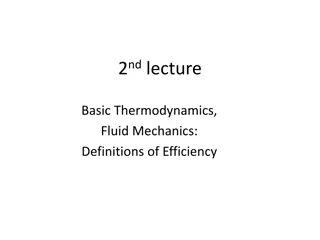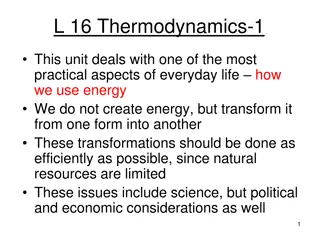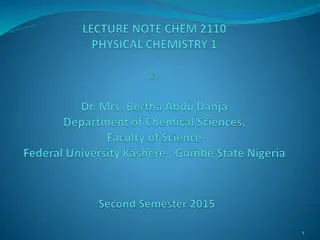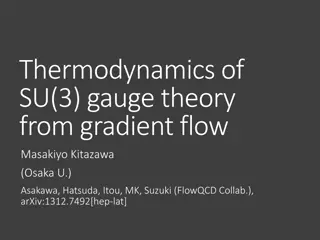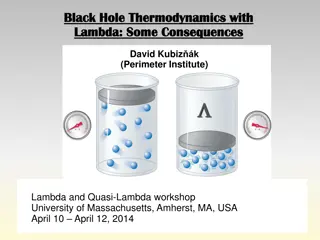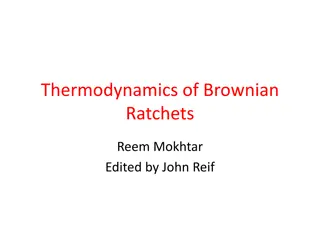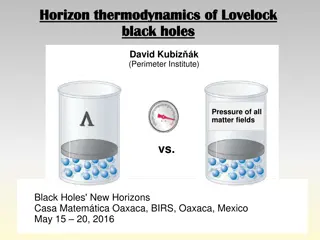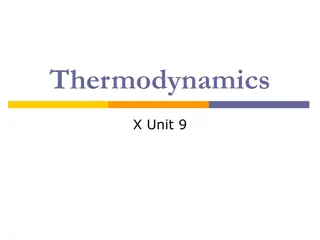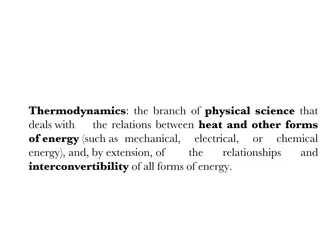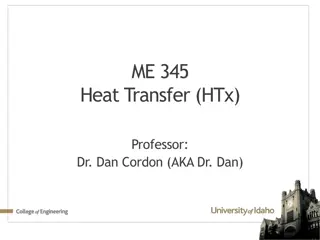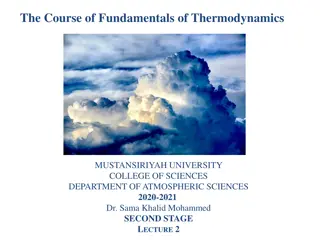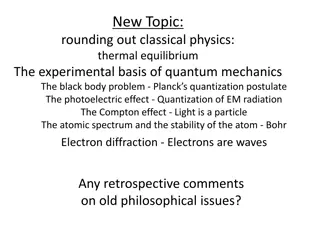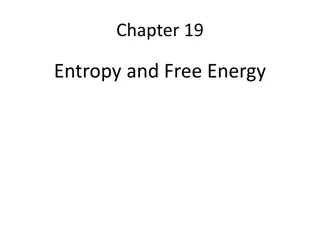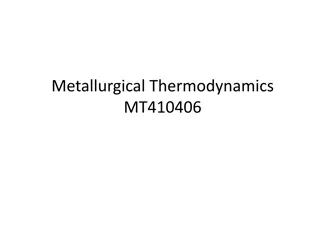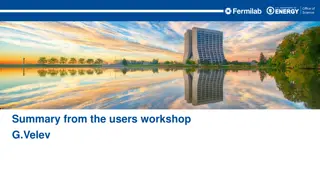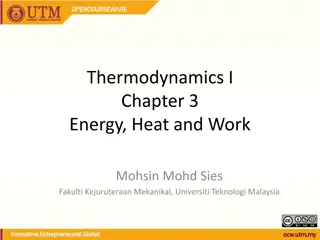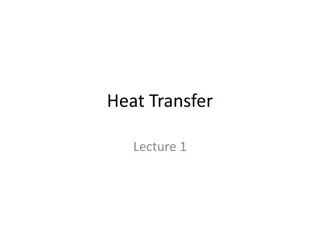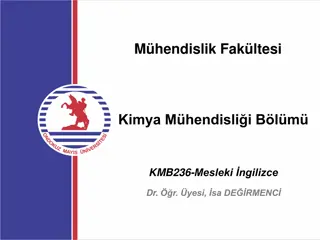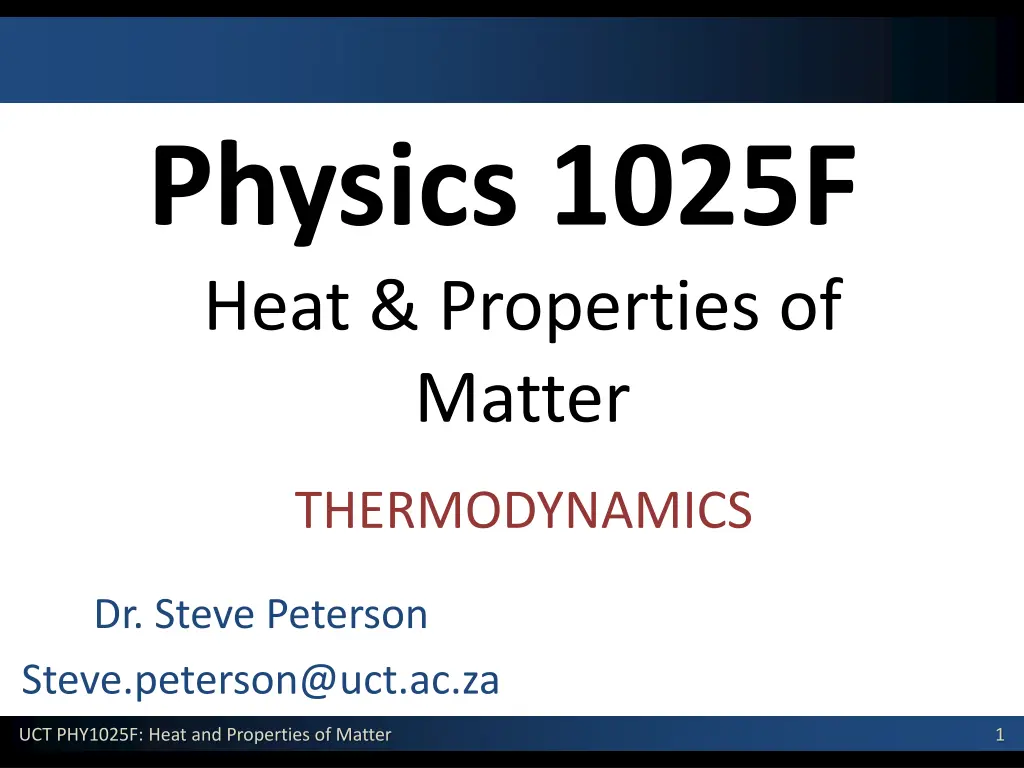
Understanding Thermodynamics: Heat, Work, and Energy Transfer in Physics
Explore the principles of thermodynamics, including the First Law, ideal gas law, and work calculations in physics. Learn about energy transfer, heat exchange, and the behavior of gases in different conditions.
Download Presentation

Please find below an Image/Link to download the presentation.
The content on the website is provided AS IS for your information and personal use only. It may not be sold, licensed, or shared on other websites without obtaining consent from the author. If you encounter any issues during the download, it is possible that the publisher has removed the file from their server.
You are allowed to download the files provided on this website for personal or commercial use, subject to the condition that they are used lawfully. All files are the property of their respective owners.
The content on the website is provided AS IS for your information and personal use only. It may not be sold, licensed, or shared on other websites without obtaining consent from the author.
E N D
Presentation Transcript
Physics 1025F Heat & Properties of Matter THERMODYNAMICS Dr. Steve Peterson Steve.peterson@uct.ac.za UCT PHY1025F: Heat and Properties of Matter 1
Chapter 15: Thermodynamics Thermodynamics is the study of heat and work. UCT PHY1025F: Heat and Properties of Matter 2
Known: The Ideal Gas Law Assume that you are familiar with the ideal gas law: PV = nRT where n is the number of moles and R is the universal gas constant. ( ( 0821 . 0 = ) ) ( = . 8 31 J mol K R ) atm L mol K Note: the term ideal is used because real gases do not follow this equation precisely. However, at pressure near 1 atm and temperatures near room temperature, it is quite accurate. UCT PHY1025F: Heat and Properties of Matter 3
Where does the Energy go? When energy is added to a substance what happens? OPTION 1: the object s temperature may increase OPTION 2: the phase of the substance may change OPTION 3: the substance may use that energy to do work (i.e. expand) First Law of Thermodynamics UCT PHY1025F: Heat and Properties of Matter 4
First Law of Thermodynamics: Work Consider a gas contained by a cylinder (volume V) fitted with a moveable piston at uniform pressure P. Determine the work done by the gas at constant pressure (isobaric process). UCT PHY1025F: Heat and Properties of Matter 5
First Law of Thermodynamics: Work = W P V When the gas expands V is positive The work done by the gas is positive When the gas is compressed V is negative The work done by the gas is negative When the volume stays constant No work is done by the gas UCT PHY1025F: Heat and Properties of Matter 6
First Law of Thermodynamics: Work = W P V Work done through volume change: The work done by the gas can also be calculated using a PV diagram, by calculating the area under the curve. Work done by the gas depends on the path followed. UCT PHY1025F: Heat and Properties of Matter 7
First Law of Thermodynamics The change in internal energy ( U) of a closed system will be equal to the heat (Q) added to the system minus the work (W) done by the system on its surroundings. = = U U U Q W f i This is the law of conservation of energy, written in a form useful to systems involving heat transfer. UCT PHY1025F: Heat and Properties of Matter 8
First Law of Thermodynamics The change in internal energy of a closed system will be equal to the heat added to the system minus the work done by the system on its surroundings. UCT PHY1025F: Heat and Properties of Matter 9
Thermodynamics Terminology System: collection of objects one is interested in Surroundings: everything else Typically, system = gas State of a system: a complete set of variables describing the system (pressure, volume, temperature, ) UCT PHY1025F: Heat and Properties of Matter 10
First Law of Thermodynamics For the First Law of Thermodynamics, the sign conventions are very important. It can be tricky trying to remember when Q and W are positive and negative. For heat Q: Heat flows into a system: Q > 0 Heat leaving the system: Q < 0 The amount of heat flowing into (or out of a system also depends on the path taken UCT PHY1025F: Heat and Properties of Matter 11
First Law of Thermodynamics Suppose system gains heat Q while no work is done = 0 = = W U U U Q f i By conservation of energy, the internal energy of the system changes: U increases if system gains heat U decreases if system loses heat Heat Q is positive when the system gains heat and negative when the system loses heat UCT PHY1025F: Heat and Properties of Matter 12
First Law of Thermodynamics Suppose system does work W on surroundings while no heat flows U Q = = 0 = U U W f i By conservation of energy, the internal energy of the system decreases: U decreases if work done by system U increases if work done on system Work W is positive when it is done by the system and negative when it is done on the system UCT PHY1025F: Heat and Properties of Matter 13
Ideal-Gas Processes We can represent the state of a gas by a point on a pV diagram. A process can be represented by a path on this diagram. PfVf Tf =PiVi Ti UCT PHY1025F: Heat and Properties of Matter 14
Thermodynamic Processes A quasi-static process occurs slowly enough that a uniform temperature and pressure exist throughout all regions of the system at all times We will consider 4 different thermal processes: isobaric: constant pressure isovolumetric: constant volume adiabatic: no transfer of heat isothermal: constant temperature UCT PHY1025F: Heat and Properties of Matter 15
Thermodynamic Processes: Isobaric Work done: area under PV curve An isobaric process is one that occurs at constant pressure Isobaric process: UCT PHY1025F: Heat and Properties of Matter 16
Problem: Isobaric Process What is the change in internal energy of the system after 1 g of water (at 100 oC) is converted to steam? Assume process is done at atmospheric pressure. (Lv for water = 2256 x 103 J/kg, 1 g of water = 1671 cm3 of steam) UCT PHY1025F: Heat and Properties of Matter 17
Thermodynamic Process: Isovolumetric An isovolumetric (or isochoric) process is one that occurs at constant volume Work done: area under PV curve Isovolumetric process: UCT PHY1025F: Heat and Properties of Matter 18
Problem: Isovolumetric Process V&S Example 12-7: How much thermal energy must be added to 5.00 moles of monatomic ideal gas at 300 K and with a constant volume of 1.5 L in order to raise the temperature of the gas to 380 K? UCT PHY1025F: Heat and Properties of Matter 19
Thermodynamic Processes: Adiabatic An adiabatic process is one in which no heat flow occurs Adiabatic Expansion: Tf < Ti Adiabatic Compression: Tf > Ti Adiabatic process: UCT PHY1025F: Heat and Properties of Matter 20
Problem: Adiabatic Process In the PV diagram shown alongside, 85.0 J of work was done by 0.0650 mole of an ideal monatomic gas during an adiabatic process. a) How much heat entered or left this gas from a to b? b) By how many joules did the internal energy of the gas change? c) What is the temperature of the gas at b? d) What is the temperature of the gas at a? UCT PHY1025F: Heat and Properties of Matter 21
Thermodynamic Processes: Isothermal An isothermal process is one that occurs at constant temperature Work done: area under PV curve Isothermal process: UCT PHY1025F: Heat and Properties of Matter 22
Problem: Isothermal Process C&J Example 15-5: Two moles of the monatomic gas argon expand isothermally at 298 K, from the initial volume of 0.025 m3 to a final volume of 0.050 m3. Assuming that argon is an ideal gas, find (a) the work done by the gas, (b) the change in the internal energy of the gas, and (c) the heat supplied to the gas. W = = 3433 + J 0 U = J 3433 + Q J UCT PHY1025F: Heat and Properties of Matter 23
Problem: Thermodynamic Processes A cylinder, fitted with a frictionless piston, contains 0.250 moles of an ideal monatomic gas at an initial pressure of 6.0 x 104 Pa and an initial volume of 3.0 x 10-3 m3. The gas expands isobarically to twice its initial volume, and then its pressure is decreased isochorically to half its initial pressure. Finally it is compressed isothermally back to its original pressure and volume. a) Draw a PV diagram showing the three stages. b) Determine the amount of work done on or by the gas in each stage, and the amount of heat flowing into or out of the gas in each stage. A to B: W = +180 J, Q = +450 J B to C: W = 0, Q = -270 J C to A: W = -124.7 J, Q = -124.7 J UCT PHY1025F: Heat and Properties of Matter 24
Human Metabolism & The First Law We can apply the first law of thermodynamics to the human body: Work W is done by the body in its various activities. In order to maintain our internal energy level, there must be energy coming in. Energy does not enter the body through heat absorption, instead the body loses heat. Rather, the energy entering the body through the chemical potential energy stored in foods. UCT PHY1025F: Heat and Properties of Matter 25
Human Metabolism & The First Law The metabolic rate ( U / t) is the rate at which internal energy is transformed in the body. UCT PHY1025F: Heat and Properties of Matter 26
Measuring Metabolic Rate The metabolic rate is related to oxygen consumption by About 80 W is the basal metabolic rate, just to maintain and run different body organs V U O = 8 . 4 2 t t UCT PHY1025F: Heat and Properties of Matter 27
Aerobic Fitness One way to measure a person s physical fitness is their maximum capacity to use or consume oxygen UCT PHY1025F: Heat and Properties of Matter 28
Efficiency of the Human Body Efficiency is the ratio of the mechanical power supplied to the metabolic rate or total power input W U = e t t UCT PHY1025F: Heat and Properties of Matter 29

